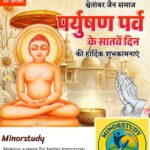Hartalika Teej, Gauri Habba, and Samveda Upakarma Bring Positivity to Life
Panchang of the Day – 26 August 2025
Day: Tuesday
Shaka Samvat: 1947
Vikram Samvat: 2082
Dishashool: Uttar (North)
Tithi: Tritiya till 01:54 PM, then Chaturthi begins
Nakshatra: Hasta – till full night
Abhijit Muhurta: 11:56 AM – 12:48 PM
Rahu Kaal: 03:36 PM – 05:13 PM
Yamaghant: 10:13 AM – 11:05 AM
Today’s Vrats/Fasts: Hartalika Teej, Gauri Habba, and Samveda Upakarma
Introduction
The beauty of India lies in its diverse yet interconnected festivals that not only celebrate divinity but also highlight deep human values. On 26 August 2025, three powerful festivals—Hartalika Teej, Gauri Habba, and Samveda Upakarma—are observed across different parts of India.
Hartalika Teej honors the devotion of Goddess Parvati and her union with Lord Shiva.
Gauri Habba celebrates Goddess Parvati as Gauri, symbolizing purity, prosperity, and feminine power.
Samveda Upakarma revives ancient Vedic learning through sacred rituals and discipline.
Together, they form a trinity of devotion, feminine strength, and spiritual renewal.
History of the Festivals
Hartalika Teej
The word Hartalika comes from Harat (abduction) and Aalika (female friend).
According to legend, Goddess Parvati’s friend abducted her so she could avoid being married to Lord Vishnu against her will. Parvati performed intense penance and was finally accepted by Lord Shiva as his eternal consort.
Since then, women observe this fast for marital bliss, devotion, and family harmony.
Gauri Habba
In South India, Gauri Habba is celebrated one day before Ganesh Chaturthi.
It honors Goddess Parvati in her form as Swarna Gauri, who comes to bless devotees with prosperity and happiness.
The day signifies Parvati’s visit to her parental home, welcomed with devotion and love, while the next day celebrates Lord Ganesha’s arrival.
Samveda Upakarma
Upakarma means “beginning” or “renewal.”
Among Brahmins, especially in South India, Samveda Upakarma marks the ritual changing of the sacred thread (Yajnopavita) and the recommencement of Vedic studies.
The day is about purification, repentance, and rededication to Vedic knowledge and discipline.
Timeline
Ancient Times: Parvati’s penance leads to the origin of Hartalika Teej; Samveda chanting forms the roots of Indian music.
Vedic Era: Upakarma rituals established as part of Brahmanical tradition.
Medieval Times: Gauri Habba gains prominence in Karnataka and Andhra culture.
2000s–Present: These festivals are celebrated globally, symbolizing cultural pride and spiritual continuity.
11 Amazing Facts
Hartalika Teej involves nirjala vrat (fast without food or water) by women for marital harmony.
In Nepal, Hartalika Teej is celebrated on a grand scale with red sarees, dances, and songs.
Samveda is called the origin of Indian classical music, making its Upakarma unique.
During Samveda Upakarma, mistakes in rituals are forgiven through prayaschitta mantras.
Gauri Habba is celebrated a day before Ganesh Chaturthi, symbolizing the mother-son bond.
Women decorate Goddess Gauri with turmeric, kumkum, flowers, and bangles.
Hartalika Teej is one of the three main Teej festivals in India—the other two being Hariyali Teej and Kajari Teej.
Upakarma means spiritual rebirth, as Brahmins renew their vows of study and purity.
The festivals emphasize women’s empowerment and community bonding.
In South India, married women exchange baskets of turmeric, kumkum, and fruits during Gauri Habba.
All three festivals promote discipline, devotion, and gratitude.
Significance
Hartalika Teej: Symbol of a woman’s determination and devotion, strengthening marriage bonds.
Gauri Habba: Celebrates feminine energy (Shakti), purity, and prosperity in homes.
Samveda Upakarma: Revives Vedic learning and self-purification through sacred thread rituals.
Observances and Rituals
Hartalika Teej:
Women wake before sunrise, bathe, wear green sarees, and apply mehendi.
A strict fast (nirjala vrat) is observed.
Idols of Shiva and Parvati are made from clay and worshipped.
Gauri Habba:
Goddess Gauri’s idol is decorated with turmeric, kumkum, and flowers.
Women invite other married women for kumkum archane.
Special dishes like kosambari and sweets are prepared.
Samveda Upakarma:
Sacred thread changing ceremony with chanting of Gayatri Mantra.
Prayers for forgiveness of mistakes in rituals.
Students resume Vedic studies after purification.
Wishing Messages
Hartalika Teej:
“May Goddess Parvati bless your marriage with harmony, love, and eternal devotion. Happy Hartalika Teej!”Gauri Habba:
“On this Gauri Habba, may Goddess Parvati fill your home with peace, prosperity, and happiness.”Samveda Upakarma:
“Wishing you spiritual renewal, knowledge, and divine blessings on Samveda Upakarma.”
FAQs
Q1. Why is Hartalika Teej important?
Because it marks Goddess Parvati’s penance and devotion, inspiring women’s strength and marital harmony.
Q2. What is the meaning of Upakarma?
It means “renewal” or “beginning,” marking purification and recommencement of Vedic studies.
Q3. Why is Gauri Habba linked with Ganesh Chaturthi?
Because Goddess Gauri is considered Lord Ganesha’s mother, her arrival precedes his celebration.
Q4. Who can observe these festivals?
Women observe Hartalika Teej and Gauri Habba, while Samveda Upakarma is observed by Brahmin men and students.
Q5. Are these festivals relevant today?
Yes—because they encourage devotion, discipline, women’s empowerment, and cultural preservation.
Importance in Life and Society
Personal Life: Promotes patience, devotion, and gratitude.
Family Life: Strengthens marital and family bonds.
Community Life: Creates social unity through collective rituals and gatherings.
Cultural Heritage: Preserves Vedic knowledge, folk traditions, and feminine celebrations.
Society at Large: Emphasizes respect for women, purity in actions, and the value of discipline.
Daily Life Impacts
Discipline through fasting teaches endurance and self-control.
Mental peace through prayers and chanting reduces stress.
Cultural bonding brings families and communities closer.
Women empowerment highlights their spiritual and social strength.
Spiritual renewal motivates purity in thoughts and deeds.
Conclusion
The observance of Hartalika Teej, Gauri Habba, and Samveda Upakarma on the same day—26 August 2025—is more than just coincidence. It’s a reminder that life is a blend of devotion, feminine energy, and discipline.
From Parvati’s determination on Hartalika Teej, we learn faith and commitment.
From Gauri Habba, we learn to honor the feminine force of prosperity and purity.
From Samveda Upakarma, we learn renewal, discipline, and the power of sacred knowledge.
In modern times, these festivals go beyond rituals. They heal relationships, strengthen society, empower women, preserve culture, and inspire positivity.
So, as we observe these sacred festivals today, let’s carry forward their timeless message: live with devotion, discipline, gratitude, and harmony.







